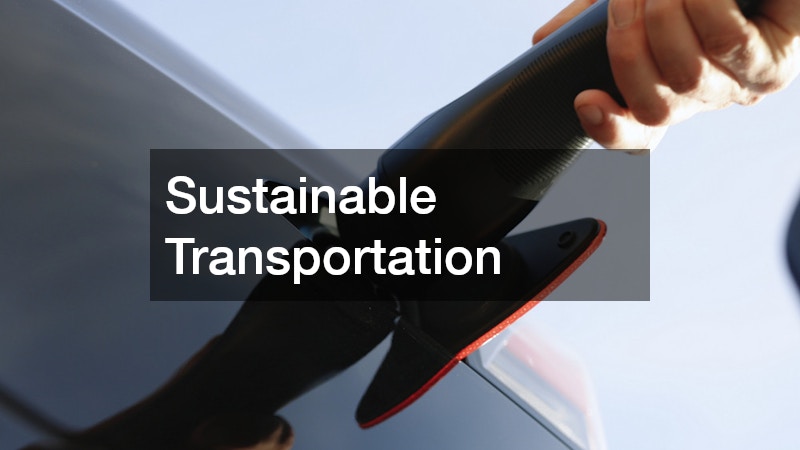Simple Ways Your Family Can Make Green Choices For a Sustainable Life


Sustainability is more than just a buzzword—it’s a commitment to future generations. As families become more aware of the environmental challenges facing our planet, there is a growing interest in making lifestyle changes that support long-term ecological balance. Living sustainably doesn’t have to involve huge sacrifices or expensive upgrades. In fact, making simple, practical adjustments to daily routines can go a long way toward protecting natural resources, reducing waste, and promoting a healthier lifestyle.
The journey toward a sustainable life starts at home. Every family, regardless of size or budget, can begin to make environmentally responsible decisions that contribute to a greener planet. From reducing energy consumption to minimizing plastic use and improving how we handle household waste, the opportunities are endless. Teaching children the importance of these changes also ensures that sustainable habits are passed down to future generations.
This guide explores several simple yet impactful ways families can embrace sustainability. Each section focuses on a specific action area that offers realistic changes any household can adopt. Whether you’re aiming to conserve water, reduce carbon emissions, or just be more mindful of your purchases, the ideas here will empower your family to take meaningful steps toward a greener future. With consistent effort and a collective mindset, small changes can lead to significant environmental benefits over time.
Let’s explore how your family can make green choices part of everyday life, creating lasting habits that benefit both your household and the world around you.
1. Rethinking Your Home Energy Use

Conserving energy at home is one of the most effective ways families can adopt green choices for sustainable living. By becoming aware of how much energy is used daily, families can take immediate steps to reduce waste. For example, switching to energy-efficient LED bulbs, turning off lights when leaving a room, and unplugging appliances when not in use are all simple habits that add up over time. Investing in smart thermostats can also improve energy use by optimizing heating and cooling based on family routines.
Incorporating tankless water heaters into your home setup is another efficient way to save energy. These systems heat water only when it’s needed, unlike traditional heaters that keep water hot continuously. This not only lowers energy consumption but also reduces monthly utility bills. Families looking to upgrade their home should consider this eco-friendly option.
By making these types of green choices, households can enjoy more comfortable living spaces while also reducing their environmental footprint. The key is to be mindful of consumption and prioritize upgrades that provide long-term energy efficiency. Over time, these changes can result in both environmental and financial rewards.
2. The Role of Technology in Supporting Sustainability
Technology can be a powerful ally in helping families lead a more sustainable lifestyle. By leveraging smart devices and online platforms, households can track energy use, control home systems remotely, and stay informed about environmental issues. Simple steps such as installing motion sensors for lighting or using smart plugs for appliances can drastically improve how energy is used.
Partnering with it support services can also make a difference. These experts can help set up and maintain energy-efficient systems, ensure cybersecurity when using smart devices, and recommend sustainable tech solutions for the home. For example, cloud storage and digital documentation reduce the need for paper, while energy-saving settings on computers and printers can help cut back on electricity usage.
Making these technological green choices doesn’t require an overhaul of your lifestyle—just smart adjustments. By optimizing how your family uses tech, you can ensure your household operates in an eco-friendly and efficient way. Plus, these actions often save time and money, making sustainability a more attractive and practical goal.
3. Enhancing Your Home Exterior
Many homeowners focus on the interior when going green, but the exterior offers just as many opportunities. Making smart decisions about building materials and maintenance routines can have a significant environmental impact. One effective change is choosing vinyl siding installation for your home. Modern vinyl siding options are durable, recyclable, and require minimal maintenance, reducing both long-term costs and waste.
Incorporating native plants and a rainwater collection system into your landscaping also makes a big difference. These eco-friendly methods minimize water usage and support local ecosystems. Moreover, using permeable materials for driveways and walkways can help reduce runoff and improve groundwater recharge.
Making these green choices enhances your home’s curb appeal while aligning with sustainable principles. It’s about choosing materials and designs that are built to last and minimize harm to the environment. When families take time to plan eco-conscious upgrades, the result is a more resilient and responsible home.
4. Sustainable Transportation

How your family gets around can play a large role in your carbon footprint. Simple steps like carpooling, biking, or using public transit instead of individual car trips can dramatically reduce emissions. For those who drive regularly, it’s important to keep vehicles well-maintained to ensure they run efficiently.
Reliable auto repair shops that focus on eco-friendly practices, such as proper disposal of oil and recycling of parts, can support this goal. Additionally, switching to hybrid or electric vehicles is a significant investment in a cleaner future. Even using apps to plan efficient routes or track mileage can help reduce fuel consumption.
These transportation-related green choices not only reduce your environmental impact but can also save money on fuel and maintenance in the long run. By adopting smarter ways to travel, families contribute to cleaner air and a healthier community.
5. Eco-Friendly Indoor Environment
The inside of your home should reflect both comfort and sustainability. One impactful way to improve your living space is by installing solar shades indoor. These window treatments reduce the need for artificial cooling by blocking out excess heat from the sun, helping maintain a consistent indoor temperature.
Solar shades also protect furniture and flooring from UV damage, extending the life of household items and reducing waste. They are available in a range of styles and colors, allowing families to make eco-friendly upgrades without sacrificing aesthetics. Another tip is to choose eco-certified cleaning products and low-VOC paints to improve air quality.
Integrating these indoor green choices creates a healthier, more efficient household. The goal is to make small, purposeful improvements that collectively promote a sustainable lifestyle while also enhancing comfort and style.
6. Reducing Waste with Everyday Habits
Families generate a surprising amount of waste, but simple adjustments can lead to significant reductions. Everyday items like reusable shopping bags, stainless steel water bottles, and bulk food storage containers help eliminate single-use plastics. Composting is another excellent habit that transforms organic waste into valuable fertilizer for gardens.
Making intentional green choices when shopping—such as avoiding excessive packaging or choosing products made from recycled materials—also makes a big difference. Reusing and repurposing items rather than discarding them extends product life and reduces the demand for new resources.
By staying mindful and making waste-reducing habits second nature, families can drastically cut down on landfill contributions. The key is consistency and a willingness to make smarter everyday choices.
7. Cleaning with a Purpose

Household cleaning plays a role in sustainability too. One way families can be more eco-conscious is through regular ac duct cleaning. Clean ducts improve airflow, reduce the strain on HVAC systems, and help maintain indoor air quality, all of which contribute to lower energy usage.
Additionally, choosing biodegradable or plant-based cleaning products ensures harmful chemicals don’t end up in water systems. Families can also make their own natural cleaning solutions using vinegar, baking soda, and lemon.
Incorporating these cleaning-related green choices helps create a safer home environment while reducing environmental impact. It’s not just about clean surfaces, but also about clean air, water, and energy use.
8. Responsible Food and Consumption Habits
What your family eats and how food is handled can significantly affect your environmental footprint. Reducing food waste is one of the most immediate and impactful steps you can take. Planning meals, saving leftovers, and composting scraps are practical actions that make a difference.
When shopping, choose locally sourced and organic foods when possible. Supporting a local restaurant that prioritizes sustainable ingredients is another way to practice responsible consumption. Additionally, families can grow herbs or vegetables at home to reduce reliance on store-bought items.
These food-related green choices are not only better for the environment but also encourage healthier eating habits. It’s about mindful planning and valuing the resources that go into each meal.
9. Supporting Family Wellness Through Sustainability
Health and sustainability go hand in hand. Choosing wellness services that align with eco-conscious values benefits both people and the planet. For example, visiting a local vitamin c infusion center that uses environmentally friendly practices supports your health while minimizing waste.
Similarly, selecting eco-friendly personal care products or engaging in outdoor family fitness activities instead of energy-intensive indoor gyms can contribute to greener living. These options support well-being while reinforcing sustainable values in everyday life.
Such green choices make it easier for families to maintain their health without compromising on environmental responsibility. It’s about finding balance between self-care and planetary care.
10. Involving Kids in Sustainable Activities

Involving children in sustainability teaches valuable life skills and builds eco-conscious habits from an early age. Kids can help with recycling, gardening, and even participating in community cleanups. Providing age-appropriate books and documentaries about environmental topics can also help spark their interest.
Engaging children in these green choices builds a strong foundation for lifelong environmental responsibility. It also empowers them to feel that their actions matter, fostering a sense of stewardship and connection to nature. Education and participation go hand-in-hand in nurturing the next generation of environmental advocates.
11. Prioritizing Green Healthcare Options
Medical care may not immediately come to mind when thinking about sustainability, but it plays an important role. For instance, visiting an orthopedic clinic that implements green practices, such as electronic health records or energy-efficient facilities, can reduce resource use without sacrificing quality of care.
Families can also reduce their healthcare-related carbon footprint by combining appointments, choosing local providers, and utilizing telemedicine options when appropriate. These small steps, combined with other green choices, contribute to a more sustainable healthcare experience.
By being intentional about where and how healthcare services are accessed, families can support both their well-being and the planet.
12. Combining Efforts for a Holistic Impact
Creating a sustainable lifestyle isn’t about perfection—it’s about progress. Combining several strategies discussed throughout this guide can lead to a well-rounded and impactful approach to sustainability. For instance, a family might use energy-efficient appliances, reduce food waste, carpool to school, and maintain their HVAC systems regularly.
Choosing to support a restaurant that prioritizes local ingredients while also shopping from green-focused retailers can amplify your impact. When these choices are made collectively, they create a synergy that enhances overall effectiveness.
Moreover, collaborating with your community or neighborhood association can magnify your efforts. Hosting eco-workshops, organizing recycling drives, or promoting solar energy solutions are ways families can advocate for sustainability beyond their household.
These combined green choices not only build a better environment but also foster a sense of unity and purpose among community members. They remind us that we are all stewards of the Earth, capable of meaningful change when we work together.
Sustainability is a continuous journey, not a destination. By adopting simple, consistent practices, families can make a meaningful difference in the health of our planet. This guide has highlighted practical and approachable ways to begin that journey, from reducing energy use and waste to improving how we eat, shop, travel, and care for our homes and bodies.
Every choice matters, and when made intentionally, even the smallest action can lead to significant positive outcomes. Choosing to embrace green choices as a family sets an example for children, influences neighbors, and contributes to a broader cultural shift toward environmental responsibility.
The best part is that these changes often come with additional benefits: cost savings, improved health, stronger community ties, and a deeper connection to the world around us. Sustainable living doesn’t have to feel overwhelming or inconvenient. It simply requires mindfulness, education, and a willingness to take that first step.
So start today. Assess your habits, involve your family, and make the decision to live more sustainably. Whether it’s through energy-efficient upgrades, reducing food waste, or supporting eco-conscious businesses, every action counts. Together, we can build a greener, healthier future for generations to come.